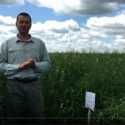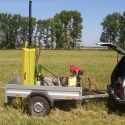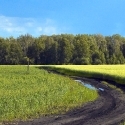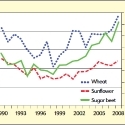16 Jan 2012
Status of Grain Maize Production and Agronomic Efficiency of Mineral Fertilizer Use
V. Nosov

Southern Russia, the major grain maize producing region in the country, consists of the Southern Federal District and the Northern Caucasus Federal District (founded in 2010). However, it is apparent from recent years that maize is continuing to expand into central Russia, which is decreasing the south’s share of total maize area and production (Table 1). In 2009, the area planted to maize in Southern Russia was distributed as follows: 46% in Krasnodar Krai, 20% in Northern Caucasus Republics (mainly Kabardino-Balkariya and Northern Osetiya-Alaniya), 19% in Rostov Oblast, 9% in Stavropol Krai, and 7% in Volgograd Oblast (ROSSTAT, 2010). Rainfed maize is grown mostly on leached, typical, and common chernozems. Irrigated maize is produced on southern chernozems and light chestnut soils. As shown in Table 2, the lowest maize yields are observed in the driest regions such as Rostov and Volgograd Oblasts, whereas the highest yields occur in Krasnodar Krai, which is the most favorable region in terms of climatic and also socio-economic conditions for agriculture.
Rainfed maize in Southern Russia is mainly grown between winter wheat and soybean, alternating with soybean, or following maize in a 2-year cropping sequence. Maize may also be included in extended rotations such as soybean or peas-winter wheat-winter barley-maize-winter wheat-sunflower.
Limited fertilizer use is likely an important factor that contributes to the low average yields of maize in Southern Russia. For example, in 2009 agricultural enterprises of the region applied on average 40 kg N, 16 kg P2O5, and 5 kg K2O per hectare for grain maize production (Table 2).
When precipitation is adequate, it is recommended to make a basal fall application of NPK fertilizers and spring preplant N application. Sidedressing N and incorporation into the soil by cultivator-fertilizer applicator is popular in Krasnodar Krai. Sidedressing 30 kg N/ha on common chernozems at the V5-V7 stage increased grain yield by 4 to 12% (Malakanova et al., 2009). Field experiments conducted on a leached chernozem of the same region (Toloraya et al., 2008) evealed
that a soil-incorporated sidedress application of 30 kg N/ha + 20 kg P2O5/ha + 20 kg K2O/ha at the V5-V6 stage…in addition to a fall application of 60 kg N/ha + 60 kg P2O5/ha + 60 kg K2O/ha… resulted in a 14% grain yield increment (equivalent to 1.0 t/ha) compared to the fall-only basal fertilizer application (Figure 1).
The role of K fertilizer in Southern Russia’s agriculture is underestimated. For a long time, the soils of the region have been considered as very rich in available K, enough for obtaining high yields of crops. Nevertheless, recent field experiments indicate rather high efficiency of K fertilizer use in various crops. In a 3-year field experiment conducted in Stavropol Krai, for example, the average grain yield of maize increased from 6.22 to 6.95 t/ha or by 12% due to the application of 60kg K2O/ha compared to the treatment with only N fertilizer application (Shmalko and Bagrintseva, 2007). The treatment with NP fertilizers yielded 7.04 t/ha, and the maximum yield of 7.42 t/ha was obtained with NPK fertilizer application. This field trial was conducted on a common chernozem with 257ppm as K2O, which is a level that exceeds the medium category for available K extracted by 1% (NH4)2CO3.
The agronomic efficiency (AE) of NPK fertilizers applied to various maize hybrids varied considerably, although it tended to increase with annual rainfall (Table 3).
Kravchenko (2009) studied the response of eight maize hybrids of various maturity to 80 kg N/ha + 80 kg P2O5/ha + 80 kg K2O/ha applied in the fall prior to tillage + 30 kg N/ha applied in the spring prior to cultivation on a leached chernozem. He reported that one medium-early maturing hybrid and two early maturing hybrids were less responsive to NPK fertilizer (2.7 to 8.4 kg grain/kg NPK) than medium and medium-late season hybrids. Bagrintseva et al. (2009) also found increasing AE of NPK with later maturing hybrids. When maize was grown after winter wheat the 3-yr average AE of NPK fertilizer was 3.5, 6.5, and 10.5 kg grain/kg NPK, for medium-early, medium and medium-late season hybrids, respectively. Although the same tendency of higher response of later maturing hybrids to fertilizer was revealed when maize followed spring barley, the AE figures were lower: 1.2, 4.6, and 7.9 kg grain/kg NPK,for medium-early, medium, and medium-late season hybrids, respectively.
The calculations indicate that fertilizer application rates recommended for high yielding maize in this soil-climatic zone (110 kg N/ha + 80 kg P2O5/ha + 80 kg K2O/ha) could be profitable in 2009 if the AE of NPK exceeded 5.9 kg grain/ kg NPK, excluding the costs of fertilizer delivery to the farm, fertilizer application, and additional harvesting and drying for the yield increment. For example, in the above-cited field experiment (Kravchenko, 2009), NPK fertilizer application was not profitable for two of the eight maize hybrids studied, which could be considered as an investment in building-up soil fertility without direct effect on maize yield. Two additional factors that need to be considered for more precise economic considerations are the residual effect of fertilizers and the low farm gate grain prices in Russia compared to the world market. The latter raises the profitability boundary of fertilizer use in the country.
As a whole, the low efficiency of fertilizer use in maize when applied at recommended rates in most of the presented research experiments presents a serious question. It seems important to adjust existing fertilizer recommendations by taking into consideration the nutrient demand of modern maize hybrids. This adjustment could be based on field experiments that need to be conducted in the different soil-climatic conditions of the maize growing regions. This will allow both to improve economic returns on fertilizer investments and to maintain soil fertility. Results of recent shortterm field experiments conducted in Southern Russia allow us to conclude that later-maturing hybrids responded better to fertilizer compared to early maturing hybrids.
References
Bagrintseva, V.N. and G.N. Sukhoyarskaya. 2009. Agrochemistry, 4: 38-42. (In Russian).
Bagrintseva, V.N., V.F. Nechaev, V.S. Vardanyan et al. 2009. In V.S. Sotchenko (ed.). Breeding. Seed Production. Maize Cultivation Technology. Russian Maize Res. Inst., Pyatigorsk, pp. 224-233. (In Russian).
Beltyukov, L.P. and I.M. Tyurin. 2009. Proc. Int. Conf. on Development of Innovative Potential in Agrarian Production, Science and Education. Vol. 2. Don State Agrarian University, Persianovskiy, pp. 67-68. (In Russian).
Karova, I.A. and M.A. Shavaev. 2009. Agrochemistry, 8: 19-22. (In Russian).
Kravchenko, R.V. 2009. Agrochemistry, 8: 15-18. (In Russian).
Kravchenko, R.V., O.V. Troneva and V.I. Prokhoda. 2009. In A.A. Romanenko et al. (eds.). Genetics, Breeding and Maize Cultivation Technology. Krasnodar Res. Inst. of Agriculture, Krasnodar, pp. 205-210. (In Russian).
Malakanova, V.P., D.V. Lomovskoy, T.R. Toloraya, et al. 2009. In A.A. Romanenko et al. (eds.). Genetics, Breeding and Maize Cultivation Technology. Krasnodar Res. Inst. of Agriculture, Krasnodar, pp. 232-239. (In Russian).
ROSSTAT. 2010. Federal State Statistics Service. http://www.gks.ru/wps/portal english.
Shmalko, I.A. and V.N. Bagrintseva. 2007. Proc. Regional Workshop of Agrochemists of the Geographical Network of Field Experiments with Mineral Fertilizers in the Northern Caucasus. Russian Res. Inst. of Agrochemistry,
Moscow, pp. 155-160. (In Russian).
Toloraya, T.R., V.P. Malakanova, D.V. Lomovskoy, et al. 2008. Agrochemistry, 12: 35-39. (In Russian).




